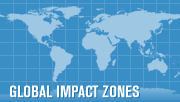At top of Greenland, new worrisome cracks in ice
The Associated Press
Seth Borenstein, an Associated Press Science Writer, reports on the newly discovered, 7-mile long crackin the northern Petermann glacier in Greenland.
- If it does worsen and other northern Greenland glaciers melt faster, then it could speed up sea level rise, already increasing because of melt in sourthern Greenland.
- "As we see this phenomenon occurring further and further north — and Petermann is as far north as you can get — it certainly adds to the concern," said Waleed Abdalati, director of the Center for the Study of Earth from Space at the University of Colorado.
- "It certainly is a major event," said NASA ice scientist Jay Zwally in a telephone interview from a conference on glaciers in Ireland. "It's a signal but we don't know what it means."
The Associated Press
At top of Greenland, new worrisome cracks in ice
By Seth Borenstein
August 22, 2008
WASHINGTON - In northern Greenland, a part of the Arctic that had seemed immune from global warming, new satellite images show a growing giant crack and an 11-square-mile chunk of ice hemorrhaging off a major glacier, scientists said Thursday.
And that's led the university professor who spotted the wounds in the massive Petermann glacier to predict disintegration of a major portion of the Northern Hemisphere's largest floating glacier within the year.
If it does worsen and other northern Greenland glaciers melt faster, then it could speed up sea level rise, already increasing because of melt in sourthern Greenland.
The crack is 7 miles long and about half a mile wide. It is about half the width of the 500 square mile floating part of the glacier. Other smaller fractures can be seen in images of the ice tongue, a long narrow sliver of the glacier.
For the rest of the article, please CLICK HERE.



